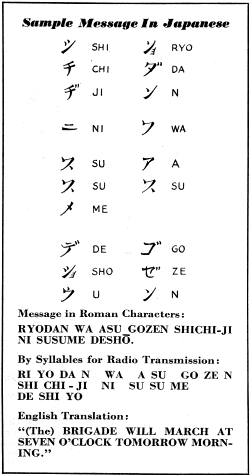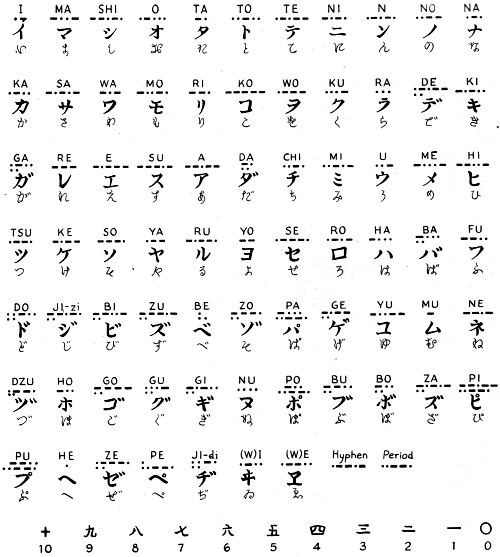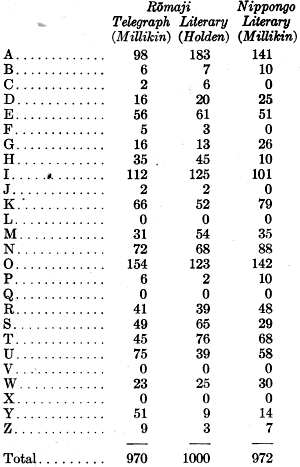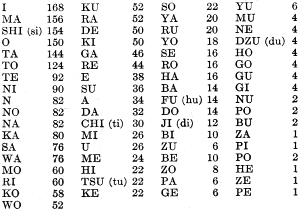The Japanese Morse Telegraph Code |
|||||
Less than a year had passed since the surprise attack on Pearl Harbor by the Japanese navy when this article was published in QST. America had sprung into high gear to help the war effort - both as civilians and as military members. A vital part of the strategy was to educate as many people as possible regarding the tactics and habits of the enemy. Media of all sorts were used to help get the word out. Yes, there was a time in this country when patriotic Americans banded together proudly and unabashedly toward the common cause of survival for our heritage and established way of life. Even major magazine publishers, television broadcasters, and Hollywood actors lent their talents. A host of young and even middle-age boys and men responded to their country's call to service. QST did its part, probably more so than most forms of media, by appealing to those people capable and willing to contribute to the vitally important task of communications. How many hobbies could be directly applied to the needs of the military and homeland defense? Precious few, other than radio design, assembling, testing, and operation. I suppose to be fair I would have to mention a few other hobbies like vehicular maintenance, firearms marksmanship, and model building... oh, and sewing for the ladies. If you know or are related to any of the authors of there articles, please thank them for all of us for their service. Let us hope that, seeing the way the country is moving these days, that their effort was not ultimately in vain.! The Japanese Morse Telegraph Code With Some Notes on the Japanese Language By Donald B. Millikin (Manhasset, N.Y.) Japanese Morse Code is used on the landline telegraph system of Japan and by Japanese ship and fixed radio stations. However, when messages are sent to foreign countries or ships they are transmitted by International Morse. Although the dot and dash signals are identical in both codes for the numerals and for the letter U, there are great differences between Japanese and International Morse. Signals for the single letters A, E, I, N (or M), and O in the Japanese system are totally unlike the equivalents in the International. The other combinations of dots and dashes represent the two-letter and three-letter groups of Romaji (pronounced ro-mä-j'e), an English language phonetic system approximating the Japanese spoken sounds. Messages in Japanese Morse may be transmitted according to the Romaji spelling or the Nippongo modification. No dependence can be placed upon frequency tables for Japanese single letter occurrences because of the differences in spelling and peculiarities inherent in the language itself; tables of digraphs and trigraphs are needed. Although the word lengths of plain language text vary greatly, messages are frequently sent in regular groups of fifteen letters each. Such com-munications are not in code, the code messages being usually transmitted in five-letter groups. Japanese Morse signals are recorded on paper tape by means of the ink-recorder just as the char-acters of the International code are received on tape. For the ideographs, or "picture-writing," that are equivalent to Romaji, both tape and page types of teleprinters are used. Accurate translations of messages transmitted in Japanese Morse would be difficult unless one were familiar to some extent with the Japanese language and the Romaji and Nippongo spellings. The following notes will be intelligible to anyone equipped to go ahead with such translations.
It is a strange fact that of these three neighboring countries between which frequent communication has existed for a great many years, China has not deviated from ideographic script, Korea in-vented an alphabet, and Japan devised a syllabary. Most of the ideographs in the Japanese language are taken from the Chinese. The Japanese found by analysis that all of the required sounds could be conveyed by less than one hundred different syllables. They selected the ideographs corresponding to these sounds and reduced them first to forms called "Hiragana" (sometimes spelled with a K - "Hiragana "). These forms were simplified later into "Katakana" A number of years ago an Englishman. J. C. Hepburn, invented the system of using Roman letters to represent the Katakana ideographs. His method is known as Romanized Kana, or Romaji. It has been used in printing Japanese and an under-standing of it is essential to the proper use of the Japanese Morse code. The Japanese used the Hepburn system until a few years ago, when they developed a. modified spelling known as "Nippongo," because they did not like employing a method invented by a non-Japanese, Twenty-two letters of our English alphabet are used in Romaji, but L, Q, V, and X do not appear as there are no similar speech sounds in Japanese. The only letters occurring by themselves are the five vowels, A, E, I, 0, D, and the consonant N (or M). All other letters appear in combinations of two or three. Only a single one-letter word exists - E. All words end in a vowel or N. Digraphs and trigraphs always end in a vowel. The vowels may be short or long. Long I is always doubled and written as II, to avoid confusion between I and T. The other four vowels are sometimes doubled to indicate the long sound, as AA and EE, or a line is placed above them, e.g., O and U. In the trigraph SHO at the end of a word the ideograph for U is add when the O is long. C, F, and J occur only in the syllables CHI, FU, and JI, in Riimaji. They are absent in Nippongo. Consonants doubled are NN, PP, SS and TT. When the combination HA is a part of a word in Kana characters it is pronounced and written in Romaji as HA; but when it occurs alone as a two-letter word it is pronounced and written WA. Whenever KA appears by itself at the end of a sentence it is not a word but indicates interroga-tion. If the letter N occurs before B or P it is pronounced and written as M. The word NO has many meanings and may also be used as the apostrophe ('). It is a contraction for the . word MONO and may be further contracted to N', in this particular case. KOTO is used occa-sionally in the place of NO. The names of the numerals are as in Chinese:
The number twelve is written Ju Ni. Thirty-five is San Ju Go (3 times 10 plus 5).
Nippongo Modification Some examples of changes from Romaji to Nippongo are: Single Syllables SHI becomes SI FU becomes HU CHI " TI JI " ZI or DI TSU " TU DZU " DU Compound Syllables SHI and Y A, or SHA, becomes SYA CHI and YA, or CHA, " TYA JI and YA, or JA, " ZYA SHI and YU, or SHU, " SYU CHI and YU, or CHU, " TYU JI and YU, or JU, " ZYU SHI and YO, or SHO, " SYO CHI and YO, or CHO, " TYO JI and YO, or JO, " ZYO
The spellings of words are changed, e.g.: UJI to HUJI SHINTO to SINTO SHIMA to SYAMA CHOSEN to TYOSEN
This chart, designed by Charles E. Holden, shows the characters of the Japanese language in order of frequency of appearance. In each group are Roman letters showing the English spoken equivalents or "Romaji"; the dots and dashes of the Japanese Morse code; the heavy characters of the Katakana ideograph equivalents; and the lighter Hirakana equivalents, used principally for letter writing and newspaper type. There is only one set of ideographs for the numerals, and the telegraph code equivalents are the same as in International Morse. The code symbol for a hyphen is also used before a vowel to indicate that it is long. Note that some characters have two groups of dots and dashes for their code equivalents.
The effect of the Nippongo modification may be seen in these tables of single-letter frequency of occurrence. A count of telegraph text is also shown; the tendency to omit unimportant words and to abbreviate results in somewhat different figures. Note that in Nippongo the occurrences of C, F and J have dropped to zero. The literary Romaji statistics have been reduced from a count of 5118 letters. Analytical Data Here is a table of digraphs and their supporting single vowels, listed in order of frequency of ap-pearance in the Japanese language, based on a literary text count of 2524 (Holden). There are no other digraphs. These data can be used only after Japanese characters have been translated into Romaji, of course.
The author is indebted to Messrs. Charles E. Holden and Frank L. Jackson, both of New York City, whose studies of the Japanese language have been helpful in the preparation of this article. The chart on page 24 is the work of Mr. Holden.
Posted February 10, 2020 |
|||||

 Notes on the Japanese Language
Notes on the Japanese Language 

